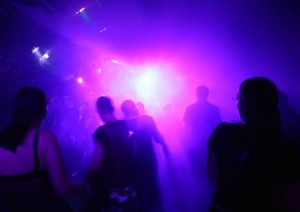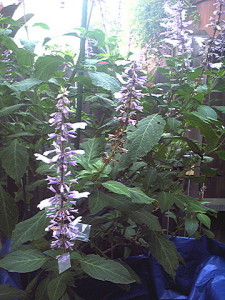
On January 23, 2006, after spending the weekend filling out applications for college and talking to his girlfriend about getting married after finishing college, seventeen-year old Brett Chidester took his life. His mother told David Schaefer on “All Things Considered” that the previous August she had found out Brett was using Salvia and confronted him, asking him to stop. He agreed, and she flushed his bag of Salvia down the toilet. After his death, she discovered that wasn’t the case. She found receipts for Internet purchases of Salvia and an essay he had written about his salvia experience.
In the essay Brett wrote that tripping on salvia allowed him to give up his senses and wander into “inter-dimensional time and space.” He said that he had discovered the secrets to the universe; and that there were other worlds. He also said that earthly human existence was pointless. His mother said that the essay echoed what Brett wrote in his suicide note. She said in an ABC Nightline interview: “I think he had smoked salvia to such an extent that something happened in his brain.”
In 1962 Gordon Wasson and Albert Hofmann (the first person to synthesize and ingest LSD) collected samples of a hallucinogenic Salvia plant and sent it to Carl Epling, an American botanist, for identification as a unique species. They called it, Salvia divinorum (meaning sage of the diviners). Wasson suggested that S. dininorum could be the unknown Aztec sacramental plant called “pipiltzintzinli,” but that is not a widely accepted hypothesis.
In 1994, Daniel Seibert began to publish his investigations into the effects of Salvinorin A (the psychoactive ingredient in Salvia divinorum). This began what is now a worldwide phenomenon, with plants leaves and extracts sold online and in head shops or tobacco shops. While it is a controlled substance in some U.S. states, the DEA said the federal government has yet to classify S. divinorum under the Controlled Substances Act. Nor does it have any currently approved medical uses in the US. Seibert gave the following warning about SalvA in his 1994 article,
Salvinorin A (the major active principal of the plant Salvia divinorum) is an extremely powerful consciousness altering compound. In fact it is the most potent naturally occurring hallucinogen thus far isolated. But before would-be experimenters get too worked-up about it, it should be made clear that the effects are often extremely unnerving and there is a very real potential for physical danger with its use. . . . The majority of people who have had a full blown experience with salvinorin A are reluctant to ever do it again. Anyone choosing to experiment with this compound should always have an alert, clear-thinking sitter present to prevent them from injuring themselves or others.

According to Wasson, S. divinorum was used by the Mazatec Indians of Oaxaca, Mexico, in their healing and divination rites. Many Mazatec families possess a private supply of the plants. But the plants were not near homes or trails where they could be easily seen by others. The Mazatecs choose a remote ravine and are reluctant to reveal their growing spots.
There isn’t agreement on whether salvia leads to a depressed state or not. Daniel Seibert, an expert on the pharmacological effects of Salvia, didn’t think anyone would commit suicide as a result of a salvia experience. “That’s just so inconceivable to me.” He said that when used responsibly, it is beneficial—helpful for deepening awareness and introspection. He’s used it himself. “Sometimes I’ve taken salvia where I’ve had some difficult life situation, relationship problem, or something like that where I was uncertain about what I should do.”
Seibert isn’t the only person who sees the potential with salvia. A 2010 study by Baggott et al. concluded that salvia effects were brief, lasting between 12 and 14 minutes. Persistent adverse effects were said to be uncommon. In addition to its strong hallucinogenic effect, it also produced a subjective sense of well-being. Participants in the study reported increased insight (47%); improved mood (44.8%); calmness (42.2%); and an increased connection to the universe (39.8%). But they also had weird thoughts (36.4%); things seemed unreal (32.4%); racing thoughts (23.2%); felt like someone or something else (14%); and anxiety (9.4%). The reported abuse potential was found to be low.
A 2014 study by Kivell et al. noted that salvia has both pro- and anti-depressant effects. The short half-life makes it undesirable for clinical use. But there is hope that ongoing research into analogs for Salvinorin A (the psychoactive ingredient in Salvia) will lead to the development of anti-depression therapeutics. A 2012 study by Harden et al. in rats suggested that SalvA “reversed anhedonia” and was an effective antidepressant agent. A 2015 study reviews the pre-clinical evidence suggesting potential anti-addictive effects of SalvA and its analogs.
Psychologist Peter Addy completed his dissertation on the effects S. divinorum in 2010. His review of the literature suggested that it was extremely potent and short acting, with few reported negative consequences. It also seemed that controlled, low dose SalvA had possible antidepressant effects. He added that SalvA inebriation appeared to be unique from other psychoactive substances. Anecdotal reports I’ve read indicate it doesn’t have the same euphoric feeling as other psychoactive substances. There is also a shorter article, “Acute and Post-Acute Behavioral and Psychological Effects of Salvinorin A in Humans” from what seems to be the same reach data used in his dissertation.
Salvia has garnered some media attention (i.e., “Why is Salvia so Uniquely Terrifying?” or “Salvia: The Least Fun Drug in the World”) that raises concerns with its recreational use. Controlled, low dose SalvA may have some potential for treating acute depression. Its unique psychoactive effects appear to make it a poor choice for recreational use. Even researchers like Daniel Seibert and Peter Abby have expressed concerns about its casual, recreational use. Abby said that very few people would consider its use to be fun in any way. “It’s not a party drug.”





